How Attribution Models Can Boost Your Marketing Strategies [2023]
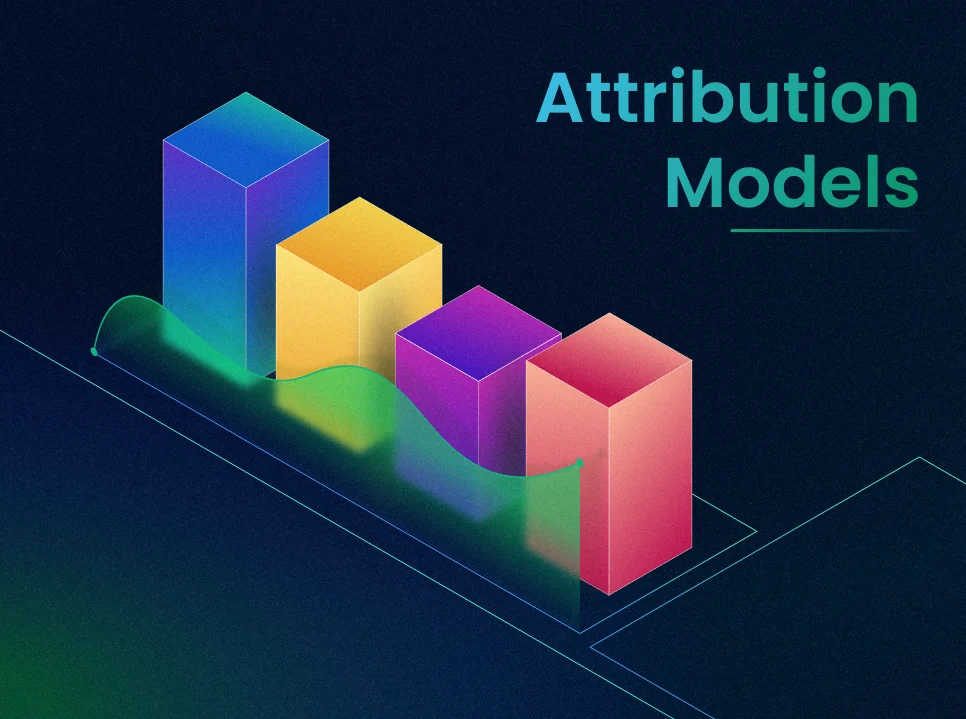
You’ve spent a lot of time and money on marketing your eCommerce business, but you’re not sure if it’s paying off. How do you know which channels are bringing in customers and which ones are just draining your budget?
That’s where attribution models come in. Attribution models are methods of measuring the impact of your marketing efforts on your sales. They help you track how your customers interact with your brand across different touchpoints and assign credit to each channel accordingly.
In this article, we will show you what attribution models are, how to choose the best one for your goals, and how to use them to improve your marketing strategy.
Let’s get started!
| Read more: |
What Is An Attribution Model?
Attribution models are methods of assigning credit or value to different marketing channels that influence a customer’s purchase decision. This model helps measure a marketing campaign’s return on investment (ROI) and optimize budget allocation and strategy.
Understanding the attribution model definition can be challenging, but it’s valuable for businesses. For a straightforward illustration, consider the following example:
Imagine you are shopping online for a new pair of shoes.
- You see an ad on Facebook that catches your eye. You click on it and browse the website but don’t buy anything. [first touch-point]
- A few days later, you get an email from the same website offering you a 10% discount. You open the email and click the link but still don’t buy anything. [second touch-point]
- The next day, you search on Google for “best shoes for running” and see the same website at the top of the results. You click on it and finally decide to buy the shoes. [final touch-point]
Now, how do you know which marketing channel was the most effective in convincing you to buy the shoes? Was it Facebook, email, or Google? Or was it a combination of all three? This is where attribution models come in.
Attribution models are essential for eCommerce businesses that want to understand customers’ behavior and preferences. There are multiple attribution models available in the market. The best attribution model for your business will depend on your specific goals and objectives. If you’re just starting, it’s a good idea to try a few different models and see which works best for you.
Attribution Model Types
Now you know the concept of attribution models. But to choose the best model for your online store, you need to understand the different types of attribution models and how they work. Let’s discover 6 most common types of attribution models:
- First-Touch Attribution Model
- Last-Touch Attribution Model
- Linear Attribution Model
- Time-Decay Attribution Model
- U-shaped Attribution Model
- W-shaped Attribution Model
1. First-Touch Attribution Model
First-touch attribution model method assigns 100% credit to the first marketing channel a customer engages with before converting. To illustrate, if a customer sees a Facebook ad before buying shoes, Facebook is credited entirely for the sale.
This simplistic approach is easy to implement but fails to acknowledge other contributing channels. It suits businesses with high brand awareness and influential initial customer interactions. Additionally, it facilitates the measurement of top-of-the-funnel marketing activities such as generating traffic and leads.
Nevertheless, this model may not accurately capture the influence of other channels that may have nurtured or persuaded customers in their purchasing journey.
2. Last-Touch Attribution Model
Last-touch attribution model assigns all credit to the final marketing channel before conversion. For example, if a customer clicked on a Google ad and then bought the shoes, Google would get 100% of the credit.
Last-touch attribution model offers simplicity and ease of implementation. However, it overlooks the potential influence of other channels on the customer’s decision-making process.
This model benefits businesses with high conversion rates and a strong lasting impression on customers. It also provides valuable insights into the effectiveness of bottom-of-the-funnel marketing efforts, such as sales closures and revenue generation.
Nonetheless, it may fail to accurately reflect the impact of initial touchpoints and other contributing channels in driving conversions.
3. Linear Attribution Model
Linear attribution model is a type of multi-touch attribution model that distributes equal credit to all marketing channels the customer engages with before converting. For example, if a customer saw a Facebook ad and then bought the shoes, Facebook would get 100% of the credit.
This approach is fair and balanced but fails to consider the distinct roles and values of each channel. It suits businesses with a brief and uncomplicated sales cycle and few touchpoints.
Despite its simplicity, the linear attribution model may not accurately reflect each channel’s impact on conversions.
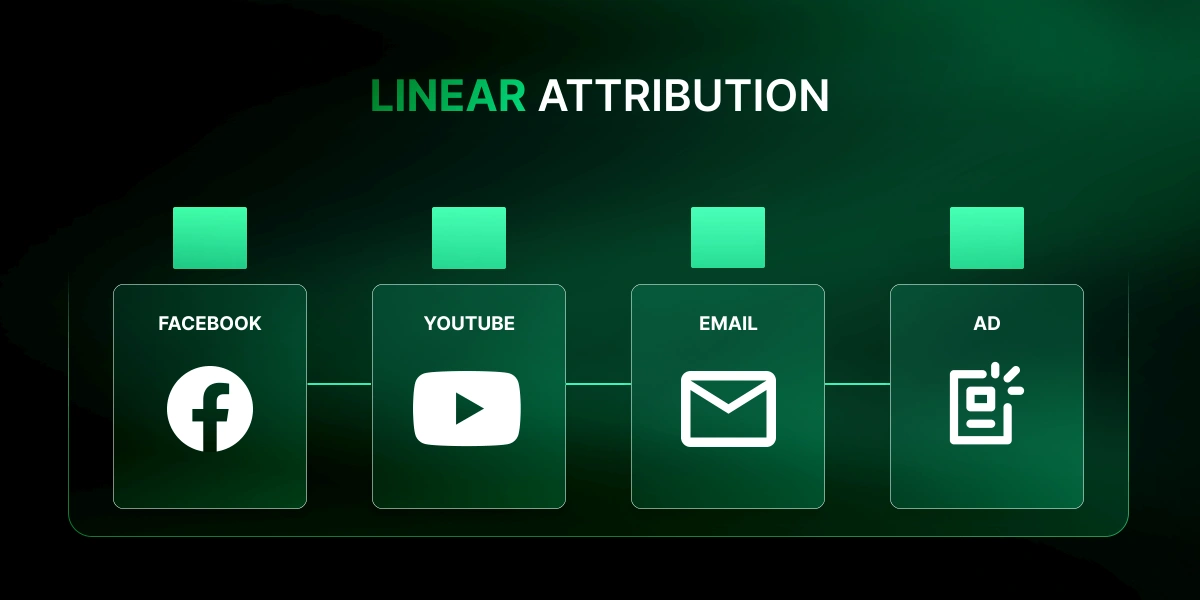
4. Time-Decay Attribution Model
The time-decay attribution model gives more credit to the marketing channels that are closer to the conversion. For example, if a customer saw a Facebook ad, clicked on a Google ad, opened an email, and then bought the shoes, the email would get the most credit, followed by Google, followed by Facebook.
Time-decay attribution model is more realistic and reflects the recency effect but may undervalue channels that initiated or assisted the conversion. It suits businesses with a long and complex sales cycle and many touchpoints. It can also help measure the effectiveness of middle-of-the-funnel marketing activities.
However, the time-decay attribution model may not capture the importance of other channels that may have created awareness or loyalty.
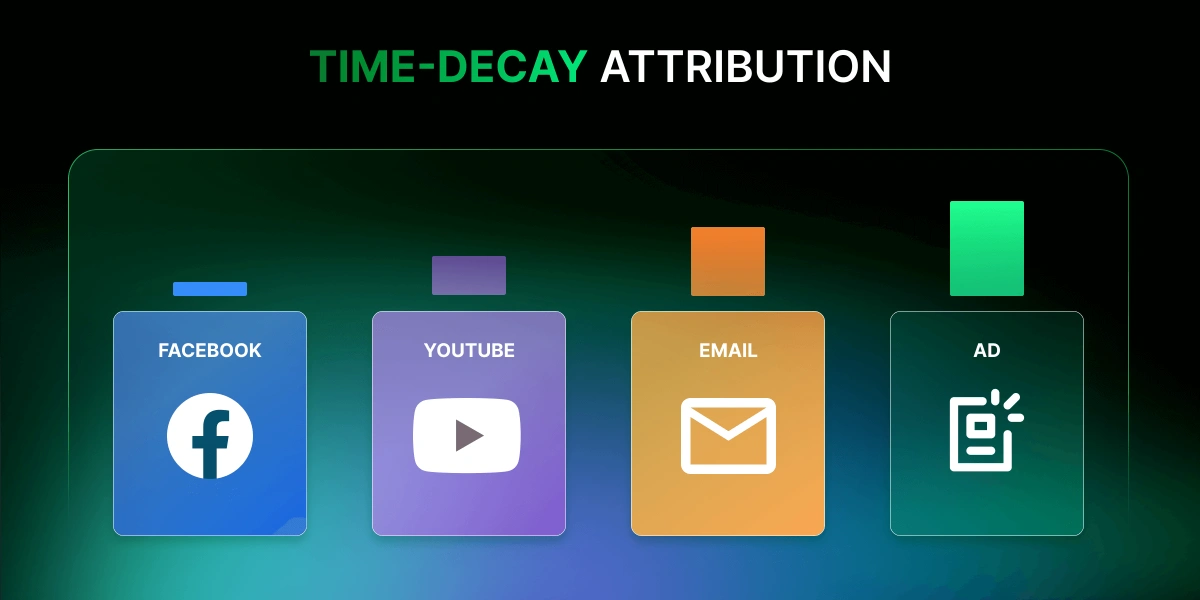
5. U-shaped Attribution Model (Position-based)
U-shaped attribution model (or position-based attribution model) emphasizes the significance of both first and final marketing channels in customer conversion. It assigns higher credit to these channels while downplaying the contribution of intermediate ones.
For example, if a customer saw a Facebook ad, clicked on a Google ad, opened an email, and then bought the shoes, Facebook and email would each get 40% of the credit, while Google would get 20%.
This model works well for businesses with a moderate sales cycle and a medium number of touchpoints. It helps measure the effectiveness of top-of-the-funnel and bottom-of-the-funnel marketing activities, like generating traffic and revenue.
However, it may not accurately show the impact of other channels that engaged or educated the customer.
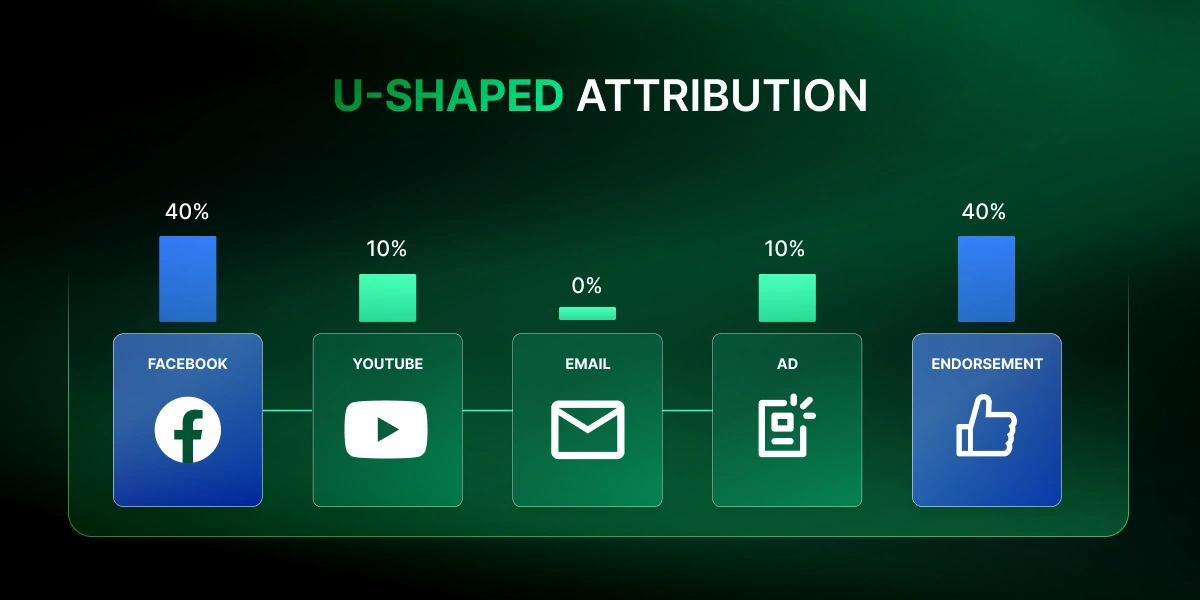
6. W-shaped Attribution Model
W-shaped attribution model is a multi-touch attribution model that prioritizes the first, middle, and last marketing channels before conversion.
To illustrate, if a customer saw a Facebook ad, clicked on a Google ad, opened an email, requested a demo, and then bought the shoes, Facebook, email, and demo would each get 30% of the credit, while Google would get 10%.
This model works well for businesses with long sales cycles and many touchpoints. It recognizes the importance of awareness, consideration, and decision stages, but it may overlook the influence of other channels that may have nurtured or persuaded the customer to buy.
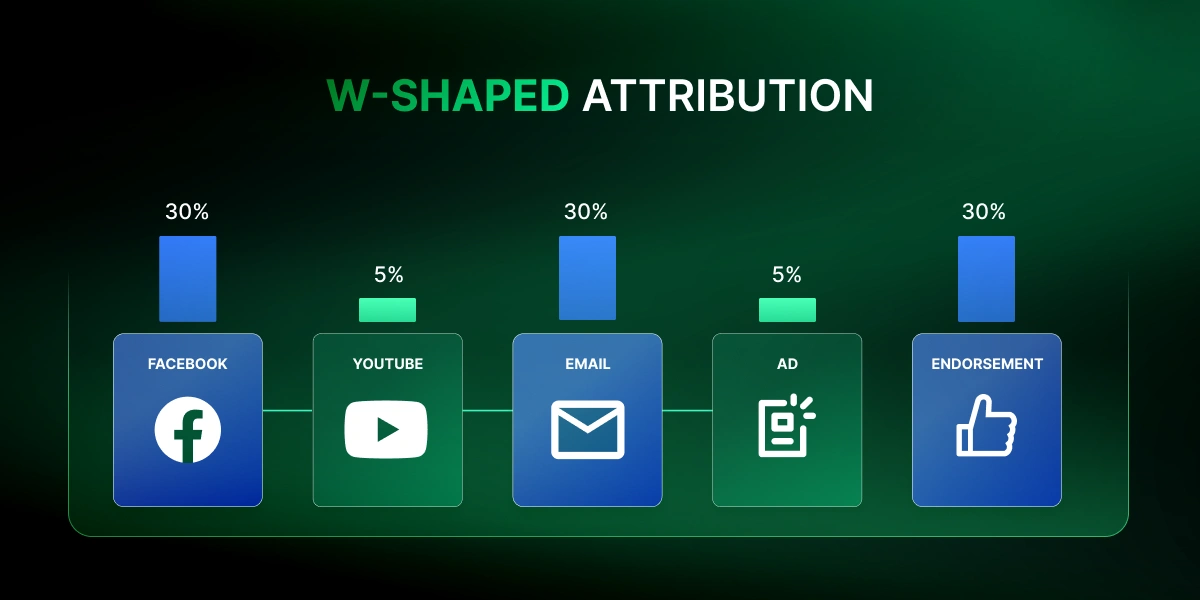
3 Popular Attribution Model Tools
Marketing attribution model tools are software apps for tracking, measuring, and optimizing marketing attribution. They gather data from multiple sources, assign credit to different channels and touchpoints using various models, and provide visualizations and reports for insights.
Let’s discover TrueProfit, CallRail, and Attribution – the 3 top-notch attribution modeling tools for eCommerce businesses.
1. TrueProfit’s Parameter Generator (most recommended)
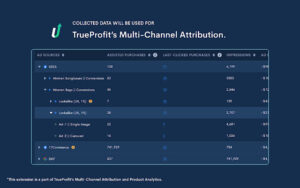
TrueProfit is a specialized attribution model tool for eCommerce stores that utilizes advanced analytics and AI to track and enhance marketing performance and profitability.
With TrueProfit’s Multi-Channel Attribution, you can effectively track the entire customer journey and identify the channels responsible for driving sales, enabling you to invest in the most profitable ones.
Additionally, you can customize the weight of each channel and touchpoint based on your business objectives and preferences.
With AI analysis, this tool provides actionable insights and recommendations to optimize pricing, inventory management, marketing budget allocation, campaign strategy, ad creative, and more.
Overall, TrueProfit Multi-Channel Attribution is a simple yet highly powerful tool for improving marketing attribution and profitability for all sizes and niches of Shopify stores.
💡 Please note that this extension is only for users who have installed and used TrueProfit, so we encourage installing TrueProfit to experience this helpful feature!
2. CailRail

CallRail is a call tracking and marketing analytics platform that allows you to measure the impact of your phone calls on your marketing attribution. It tracks and records calls from both online and offline campaigns, attributing each call to specific marketing campaigns and channels.
CallRail integrates with various analytics tools like Google Analytics, Google Ads, Facebook Ads Manager, etc., providing custom reports and dashboards for visualizing and comparing call data.
It is ideal for eCommerce businesses that heavily rely on phone calls for conversions or customer service, helping them optimize call performance and attribution.
3. Attribution
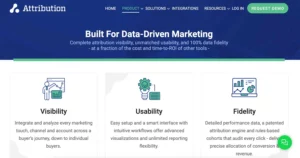
Attribution is a versatile software that accurately measures the ROI of your online marketing campaigns. It tracks and attributes every touchpoint in your customer journey, including web, mobile, social media, email, and more.
It even tracks offline conversions like phone calls and store visits. With its multi-touch attribution model and real-time data, you can confidently measure the ROI of your campaigns.
This tool seamlessly integrates with popular marketing tools like Google Analytics, Google Ads, Facebook Ads, Instagram Ads, etc., and captures offline conversions such as phone calls and store visits.
Attribution suits businesses that want to measure and optimize their online marketing performance and ROI using a comprehensive and flexible tool.
Shopify Attribution Model
Shopify’s default attribution model is last-click attribution, which only gives credit to the last channel the customer clicked on before purchasing. This can be a bit misleading and inaccurate, as it ignores all the other tracks and touchpoints that may have influenced the customer’s decision.
For example, a customer saw your Facebook ad, clicked on it, browsed your website but didn’t buy anything. A few days later, they searched for your brand name on Google, clicked on your website link, and bought a product.
➡ Shopify would attribute the sale to Google, even though Facebook may have played a significant role in creating awareness and interest.
So, if you just want a simple & easy-to-use attribution model, using Shopify’s default attribution model is a good option. However, if you wish for more accurate attribution models, then you may want to consider using a third-party attribution modeling tool.
An example of such a tool is TrueProfit, specifically designed for e-commerce stores. It utilizes advanced analytics and AI to track and enhance marketing performance and profitability. To learn more about TrueProfit, you can refer to the previous section. By utilizing TrueProfit, you can better understand your customer journey and the effectiveness of your marketing efforts.
How To Build Attribution Models?
In general, to build an attribution model, you need to follow these 5 steps:
Step 1: Collect data from all your data sources
The first step is to collect data from all your data sources. These include data from your website, marketing platforms, and CRM system.
Step 2: Pull all your data together
Next, you need to pull all your data together. This means integrating your data from different sources into a unified data source that can provide a holistic view of your customer journey and marketing performance.
Step 3: Decide on an attribution window
An attribution window is the period that you want to consider when assigning credit to each touchpoint. You need to choose an attribution window long enough to capture all the relevant touchpoints in your customer journey. But not too long that it may include irrelevant or outdated touchpoints.
Step 4: Choose an attribution model
Depending on what you want to focus on, you can choose from different types of attribution models. For example:
- If you want to see which channel sparked the interest of your customers, you can use a first-touch model.
- If you want to see which channel sealed the deal, you can use a last-touch model.
- If you want to see how all the channels work together along the customer journey, you can use a more complex model like linear, time-decay, or U-shaped.
These models assign weights to each touchpoint based on recency, frequency, or position. The best model for you will depend on your specific goals and preferences.
Step 5: Evaluate your results
Finally, you need to evaluate your results to see if it is accurate. This can be done by comparing your model’s results to your internal data or industry benchmarks.
If your model’s results are inaccurate, you may need to adjust the model or choose a different one. It is important to iterate on your model until you are confident it is accurate.
Final words
Attribution models are powerful tools that can help you optimize your marketing strategy and increase your ROI. By using the right model for your goals, you can gain valuable insights into how your customers interact with your brand and what influences their purchase decisions.
Now that you know the basics of attribution models, it’s time to put them into practice. Start by analyzing your current data and choosing a model that suits your needs. You can also experiment with different models and compare the results to see what works best for you.
Remember, there is no one-size-fits-all solution when it comes to attribution models. Find the one that matches your business objectives and customer behavior!
Discover what proper profit-tracking looks like at trueprofit.io





![Reveal The Secret Of Linear Attribution: A Closer Look [2023]](https://trueprofit.io/wp-content/uploads/2023/09/Linear-Attribution-768x572.webp)